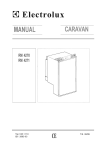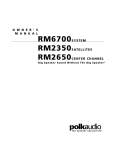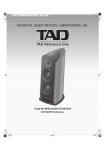Download 204 review - Gramophone Jan 1992 - meridian
Transcript
MERIDIAN 204 FM TUNER/TIMER
SPECIFICATION
FM tuning range: 88-1 08MHz
Frequency response: 20- t5.000Hz ± IdB
Sensitivity: mono 30/50dB quieting t ·5/4·0~V:stereo 23~V
Ultimate quieting: >75dB
Distortion: mono <0·2%: stereo <0-4%
Selectivity: 56dB
Capture ratio: 1·5dB
IF rejection: 100dB
AM suppression: >55dB
Output level: OdB775mV
Dimensions (H x W x D): 100 x 159 x 31Omm
Weight: 3kg
Manufacturer: Meridian Audio Ltd.. 13Clifton Road, Huntingdon. Cambs
PEI87EJ
UK retail price: £660·00
J
OHN
BaRWICK
discussed
the
original version of the 204 in July
1988, where it was reviewed as a
component part of the then new 200
Series range. Since then Meridian
have superseded the 207 CD player
with the Bitstream-based 206 player
and 208 player-preamplifier (reviewed
in July 1990) and have brought out
several other new models including a
new "Argent" range of three passive
loudspeakers (one of these, the Argent
2 was reviewed in October), the
06000 flagship digital loudspeaker
and several new electronics components in a new top-end 600 Series.
With all this high-level activity it is
remarkable that Meridian's Technical
Director, Bob Stuart, found time to
have a second look at the 204 (but
perhaps no wonder because of it that
most reviewers have passed it by in
favour of writing about the more
dramatically
new items), yet there
were several aspects of the original
design that he felt could be improved.
In effect the update to the 204 comprises an entire re-think, albeit one
which is functionally almost identical
to the original; only the metal case
and model number actually remain the
same. The current 204 has different
front-end and stereo decoder circuits
and now uses the four-layer printed
circuit board technology adopted for
the the Bitstream D/A units. This
layout effectively gives two ground
planes. which significantly enhances
the noise performance in a number of
respects. The on-board microprocessor which does all the electronic
'house-keeping'-the
programming,
channel selection, timer and display
information, and so on-is
now in a
separately screened box within the
overall case, which again has resulted
in a purer audio signal path.
Finally the optional timer output,
which can be used to control suitable
equipment from other manufacturers
and which used to be available on two
pins of the rear-panel
DIN 'bus'
socket, is now more conveniently
brought out on a single phono socket.
(Incidentally, a 'bus' in this context is
a set of interconnections, electrical or
optical,
which carries information
from one circuit to another, or from
one unit to another.)
The 204 is a high quality FM-only
tuner with presets for 18 stations. All
functions except mains on/off (for
which a rocker switch is located at the
rear) are controlled via push buttons on
the front panel. In addition, the unit
incorporates a clock/timer, the fascia's
simple four-digit seven-segment LED
(light-emitting diode) display showing
frequency, preset number or time as
required. Being part of the 200 Series,
the 204 is presented in the regulation
black livery and is contained in a single one of the extremely
elegant
building-block
'modules'
which are
common to the range (some units
occupy a pair, bolted together-for
example the 208 has its CD transport
in one and the electronics
in the
other).
The front panel is split horizontally
as usual, with a glass window for the
main display at the top and a series of
16 plastics push buttons in two rows at
the bottom. All but three of these
buttons have LEOs behind them
which register the current state of the
logic circuits. These are coloured
according to their function or primary
function: station setting is accomplished in an orange domain, timer
in case the 204 is damaged. In fact the
socket carries a 5 volts DC control
signal which drops to ground potential
(OY)
when activated.
A MosFet
device is used at the output which can
'sink' about Y2 amp so it would not be
a difficult matter for the DIY type to
make up a small unit with a relayswitched mains outlet to which one of
the many mains-activated
cassette
decks could be connected.
How it performed
options in green while mono override
and the more complex, multi-function
Mode/Store button are in red.
If
this
description
implies
something of a riot of colour the effect
in practice is anything but that, these
small points of light relieving the
otherwise austere black of the fascia.
Six buttons are devoted to the preset
stations, each having control of three
channels according to the state of two
further 'shift' keys which are also
used for selecting hours or minutes
when setting the clock or timer. Two
opaque green-co loured buttons are
used to increment frequency up or
down when tuning, or similarly for
hours and minutes. The labelling and
grouping of these buttons is entirely
logical, although -I found a need to
refer to the instruction leaflet now and
again for some of the less frequently
used functions. The rear panel carries
a fused IEC mains input socket (threecore lead with moulded plugs supplied), a female 75 ohms aerial socket,
two DIN sockets for the various 200
Series 'bus' options and gold-plated
phono sockets for the audio and Timer
outputs.
Although it can function perfectly
well as a stand-alone unit in conjunction
with
other
manufacturers'
equipment the 204 would normally
form part of a 200 Series system, in
which case the further luxury of
remote control in station selection and
manual or timed switching from or
into Standby mode becomes available
(the CD track selection buttons on the
209 Remote Control now double as
preset station selectors). Used alone
the 204 can be put back into Standby
mode only by setting the timer's offtime, as there is no dedicated Standby
button (as there is on, say, the 208),
not that that represents a significant
problem since the unit consumes a
negligible amount of power. Resetting
via the mains switch achieves the
same result. The main display has
three normal states-preset
number,
frequency or time-the
latter constantly available, even in the Standby
state, if preferred.
Tuning can be either manual, using
the up/down
buttons to set the
required frequency, or automatic in
which case a nudge of either button
sets the circuit off in search of the
next station of suitable strength; the
tuning threshold can be set to one of
eight levels to suit local conditions.
Centre tuning indication is available
and received signal strength can also
be readily assessed, the display in this
case switched to show a numerical
range between I (weakest) and 7
(strongest): Although it complicates
the user-procedure a little, I personally
like the manner in which these rarely
used functions are normally hidden
from use and indeed view, leaving
everyday use as simple and straightforward as can be. All settings are
retained
in the microprocessor's
memory,
an internal rechargeable
battery covering those periods when
the unit is actually disconnected from
the mains, which is only necessary
when long periods of absence are
envisaged-the
entire 200 Series is
designed to be left powered-up.
When used as part of a Meridian
system a bus link (lead supplied)
transfers control signals between the
various units. Bringing anyone
of
these out of Standby will activate all
of the rest so that, for example, pressing Line on the 208 or Radio on the
20 I Preamplifier will select that input
and also start up the 204 and 205
Power Amplifier-true
"music at the
touch
of
a
button"
operation.
Similarly, pressing just the required
preset radio station button on the 204
will achieve the desired result. By
setting the 204's timer the system can
be brought to life automatically,
which could be useful when one is at
home and wanting to listen to, say, a
concert but busy enough about the
house to risk missing the start. At
present there is no recording device
(i.e. tape machine) in the Meridian
range to permit completely unattended
recording,
although
their
DCC
machine, due for release next year,
will of course have this facility. We
also await with interest the Meridian
CD-R recorder previewed at Penta.
The Timer Out socket on the rear
panel can, however, be used to control
some appropriately appointed cassette
decks (some models in the Nakamichi
range are suitable, for example) but
the manual insists that a dealer be
contacted before attempting to do this
I have been a keen user of the 208
CD player/preamplifier since purchasing one following my review in July
1990, so the opportunity to experiment with the 204 was eagerly taken.
Clearly the pair make a most attractive
'front end' with the remote control
aspect a nice bonus, though it is rather
less useful with radio, I feel, than it is
for CD. In fact the one remote control
function I find really invaluable is
volume. Setting up the 204 is an easy
matter once one has read the 10-page
A4 manual, after which the concise
"Quick Operating Guide" resume at
the end is sufficient to keep to hand as
a reference when setting the timer, a
good
idea,
this
summary-more
manufacturers should adopt it. Really
the only difficulty is in remembering
some of the more esoteric functions of
the Mode/Store button, which is used
in conjunction with other keys to toggle between Step and Search tuning,
for adjusting the tuning threshold,
storing the timer details and so on (the
display can even be made to reveal the
operating software version number).
The problem is that the requisite key
sequences are not overtly logical.
Obviously this kind of set will not
find a place in the systems of radio
'hams' who like to pore over the airwaves looking for all manner of
stations-they
will want not only to
have the other AM wavebands as well
but also to have all the user functions
available on the usual plethora of
separate buttons rather than hidden
like this, and will certainly prefer a
rotary tuning knob to a pair of pushbuttons. Rather, the 204 is designed to
be installed
and then taken for
granted, a role it manages supremely
well in my view.
In terms of its audio output I could
find nothing really to fault; it conveyed a natural quality of the spoken
word on Radio 4 news programmes
with no tendency to emphasize closemiked sibilants and no chestiness; it
presented a detailed stereo stage on
first-rate symphony concert and opera
broadcasts; there were no problems
with adjacent channel breakthrough
('birdies') and the background noise
was exceptionally low.
As always with FM tuners a good,
preferably outside, aerial is pretty well
mandatory in order to obtain the best
results but given a good signal the
tuner side of the Meridian 204 really
can be set-up once and taken for
granted. For existing Meridian users it
is the obvious choice but for others
who will appreciate its excellent performance and can make use of the
timer function it is well worth considering, despite its decidedly, and to my
mind
refreshingly,
non-standard
physical size and shape.
lVOR
HUMPHREYS.












